|
H a p a g & L l o y d
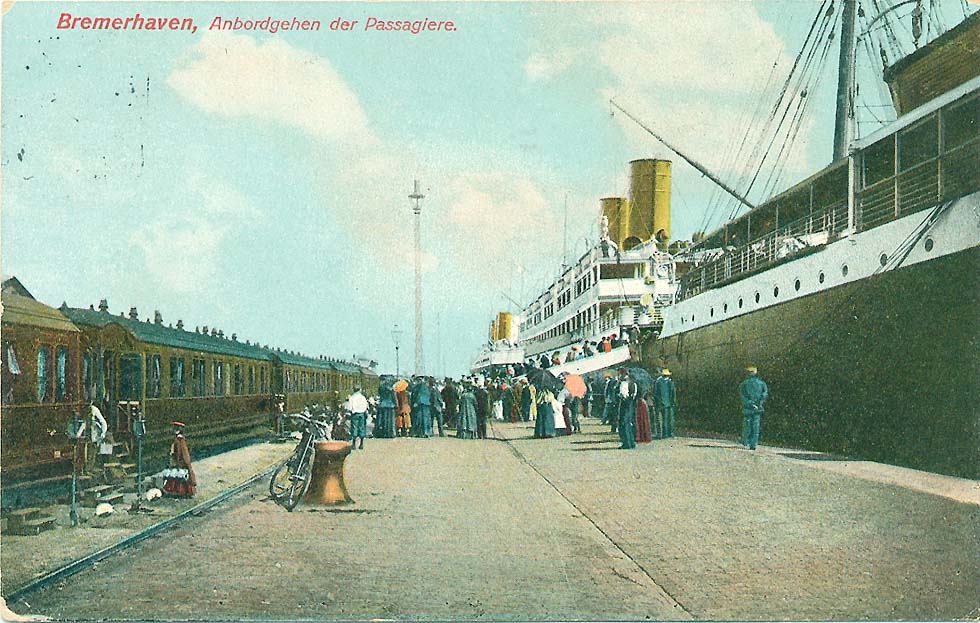
Lloyd-Sonderzug and Ocean liner at Bremerhaven, before 1911 (old postcard)
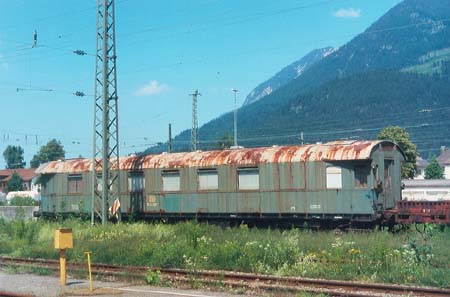
DR car series A4ü26 for Hapag specials and Lloyd specials, stored for preservation at Garmisch (WS)
|
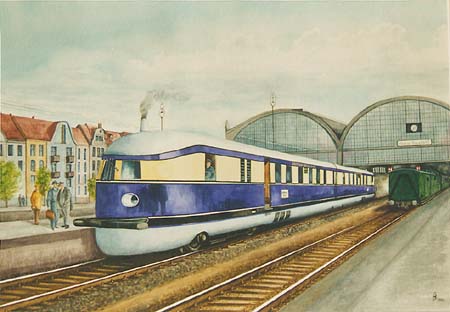
DR's original Fliegender Hamburger, departure Hamburg-Altona, a painting by Heribert Schroepfer
|
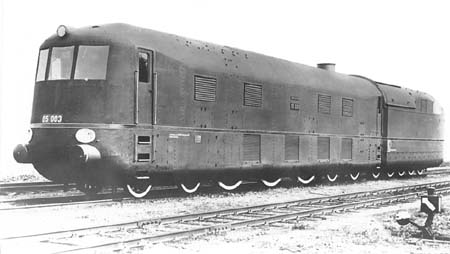
Prototype 05 003, which never entered regular service on the Berlin – Hamburg run (Borsig)
|
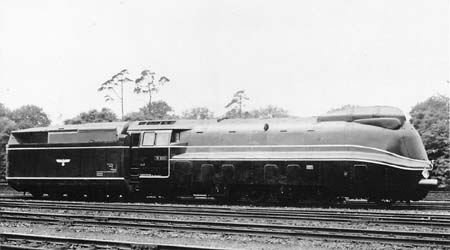
Prototype 19 1001, intended for Berlin – Hamburg (Deutsches Museum, Munich)
|
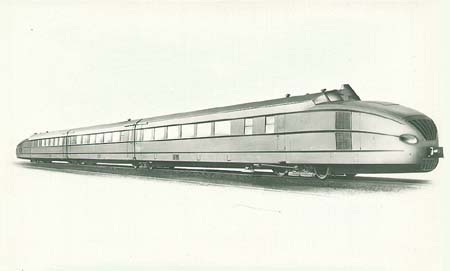
High-speed diesel prototype designed by Franz Kruckenberg
(official photograph)
|
Germany's fastest trains did run from the capital Berlin to Hamburg, the biggest port. May be the Prussian S5 Kuhn-Wittfeld prototype with cab-in-front had some trips there. In the 30's the first "Fliegender Hamburger", then VT04 railcars, and the streamlined dark-red Hudsons 05 001 and 002 ran there. The cab-in-front 05 003 (obviously dark-red too) and the 19 1001 had unsuccessful test runs. The future was represented by the streamlined silver Kruckenberg 3-unit diesel-railcar prototype, which attained 215 km/h on test runs before WWII.
The first specials for Ocean passengers may have been simple trains for emigrants form the east, separated from other passengers by health reasons. The true Ocean specials, Hapag - Sonderzug and Lloyd - Sonderzug, generally did run only from Hamburg to Cuxhaven Steubenhoeft and from Bremen to Bremerhaven, where the Columbus-Bahnhof was built. A very few exceptions were reported.
Hapag - Sonderzug Hamburg - Cuxhaven Steubenhoeft, occasionally Hamburg - Stade - Bremerhaven,
Lloyd - Sonderzug Bremen - Bremerhaven Columbus Bf.:
KPEV in 1892 ordered special bogie coaches 1st 2nd class for these services. DR introduced special 1st class compartment coaches, A4ü23 in 1925, A4ü26 in 1926, A4ü30 and 2nd class B4ü30. The 3rd class trains ran separately.
Colors: dark green. Traction: S6 (4-4-0), 17.10, 38.10 (4-6-0), later 03 (4-6-2) to Bremerhaven.
There had been various specials in other regions or countries connecting with ocean liners of several companies, but they were not as famous.
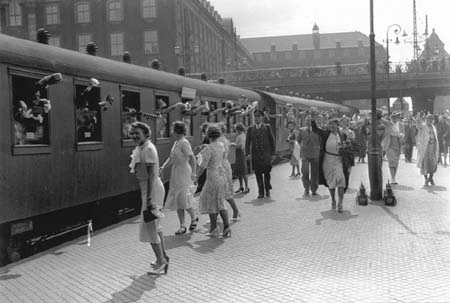
Special to Helsingor departing at Copenhagen for passengers to board a Svenska Amerika Linjen steamer at Gothenburg, in the 1930s (coll. Jens Bruun-Petersen)
|
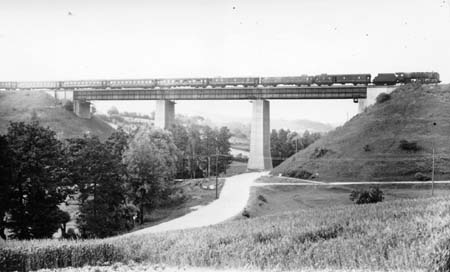
U.S. troop train, 2-10-0 type engine 44 457, near Emskirchen, June 26, 1949 (Carl Bellingrodt/ Eisenbahn-KurierEK Verlag)
|
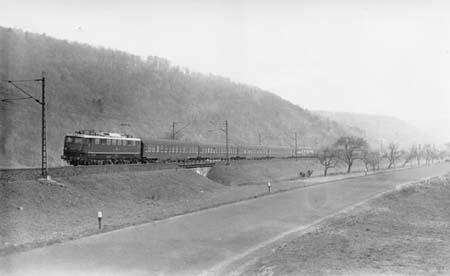
U.S. Army train with E50 015, couchette cars and diner, olive-green, near Wernsfeld 1958 (Carl Bellingrodt/ Eisenbahn-Kurier)
|
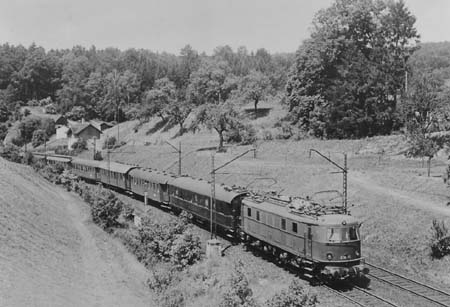
D376 Nordsee-Alpen-Express Bremerhaven-Lehe – Kassel - Frankfurt – Munich with E18 41 near Geislingen, July 1949 (Carl Bellingrodt/ coll. Heribert Schroepfer)
|
From 1945 U.S. Army trains connected with steamers at Bremerhaven, consisting of German rolling stock. The troop trains, painted olive green with a khaki stripe, did also run to Naples, with steamer connection. There were "Redeployment Trains" for "Displaced Persons" used e.g. by surviving Jews for emigration to America. A network of regular military expresses, known as DUS trains, connected the American zone of Germany, Austria and West Berlin with Bremerhaven - Lehe. Red sleepers and diners were provided by DSG and in 1950 a special sleeping-car type with "zigzag" corridor was introduced. In 1955 the train Frankfurt - Bremerhaven was stopped. New German stock, olive green, then turquoise/cream colored was introduced from 1956. In 1990 the last service form Berlin (Lichterfelde-West) to Bremerhaven-Lehe ended.
More spectacular were the pre-war fast diesel railcar sets (the later VT06), during the war used by German generals, three ones being captured on the escape ride from Berlin and then they served U.S. Army generals. A fourth one (ex 137274) was Eisenhower’s train, then brought to Fort Eustin, Virginia, together with the streamlined 19 1001 steam motor locomotive. Smaller VT04 and the new VT08 railcars came to Bremerhaven or to Frankfurt airport. The last VT08, then painted red/cream instead of olive, was preserved as “Der General”
In 1947 U.S. General Clay initiated the introduction of a train for civilians Munich - Frankfurt - Bremerhaven, the Alpen-Nordsee-Express. The D173 Munich - Bremerhaven became its successor, sometimes hauled by the semi-steamlined class 10 prototype. German Ocean specials to Bremerhaven re-emerged in the '50's, consisting of ordinary DB rolling stock. Still in the '80s the DB timetable for "Turnuszuege" mentioned specials Frankfurt - Bremerhaven. They became more and more scarce and irregular. The Berlin - Hamburg line no longer served the Ocean passengers, but in 2003 finally the dream of a high-speed train connecting the two cities became true with the ICE.
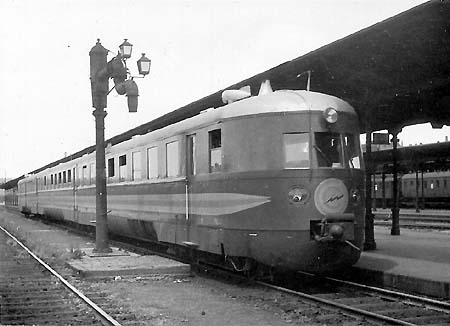
Pre-war diesel railcar set, used by U.S. General Harmon, numbered
4-44-444 (later VT 06 109), painted olive with yellow/blue stripe,
Hof 1950 (P. Buettner, MEC Hof)
|
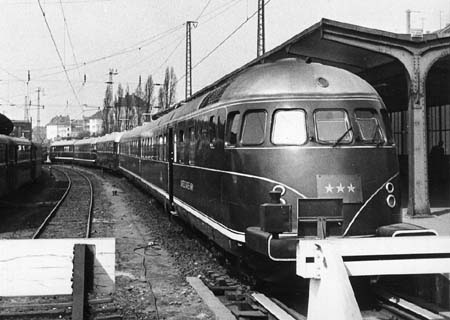
Diesel railcars VT088, VT338 and VT088, used by U.S. Generals, during a
Nato parade in Mainz, 1959 (WS)
|
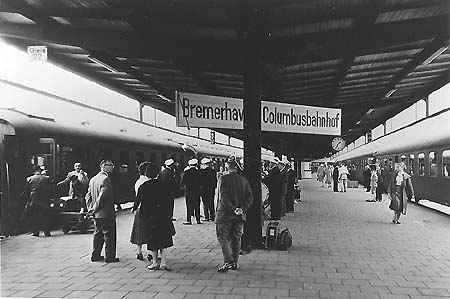
Ozeanzuege of DB at Bremerhaven Columbusbahnhof in the 50's
(DB Verkehrsarchiv)
|
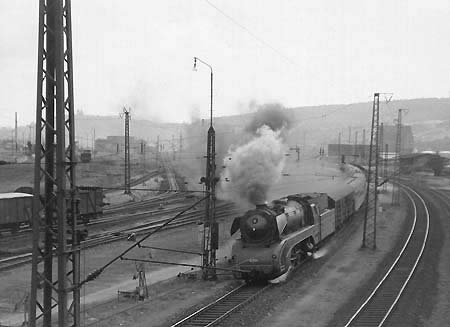
The regular D173 Munich - Bremerhaven-Lehe with prototype 10 001,
departure Wuerzburg 1958 (WS)
|
|